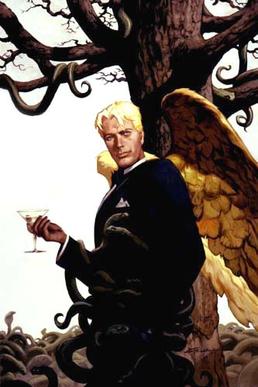
Lucifer Samael Morningstar is a character who appears in American comic books published by DC Comics. He is an adaptation of Lucifer—the Biblical fallen angel and devil of Christianity—and is one of the most powerful beings in the DC Universe. Though various versions of the Devil have been presented by DC Comics, this interpretation by Neil Gaiman debuted in The Sandman #4 in 1989. Lucifer appears primarily as a supporting character in The Sandman and as the protagonist of the spin-off Lucifer.
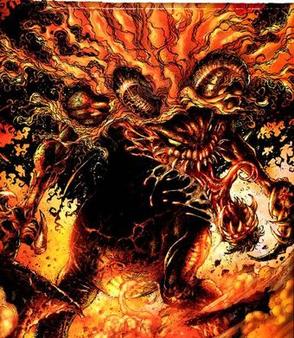
Malebolgia is a supervillain appearing as the original main antagonist in comic books featuring the superhero Spawn and reprised the role in the later issues. Created by writer/artist Todd McFarlane, the character first appeared in Spawn #1. The name Malebolgia is derived from the term in Dante's Inferno used to describe Malebolge, the ditches (bolge) in the eighth circle of Hell, where humans who committed the sin Fraud are punished. He is Spawn's former master who serves as one of the major Lords of Hell.
The Devil, appears frequently as a character in literature and various other media. In Abrahamic religions, the figure of the Devil, Satan personifies evil.

In religion and folklore, hell is a location or state in the afterlife in which evil souls are subjected to punitive suffering, most often through torture, as eternal punishment after death. Religions with a linear divine history often depict hells as eternal destinations, the biggest examples of which are Christianity and Islam, whereas religions with reincarnation usually depict a hell as an intermediary period between incarnations, as is the case in the dharmic religions. Religions typically locate hell in another dimension or under Earth's surface. Other afterlife destinations include heaven, paradise, purgatory, limbo, and the underworld.

Marduk Kurios is a character appearing in American comic books published by Marvel Comics. He is a demon who has repeatedly posed as Satan, and is the father of Daimon Hellstrom and Satana Hellstrom.
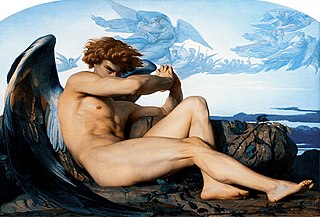
In Christianity, the Devil is the personification of evil who rebelled against God in an attempt to become equal to God himself. He is depicted as a fallen angel, who was expelled from Heaven at the beginning of time, before God created the material world, and is in constant opposition to God. The devil is identified with several figures in the Bible including the serpent in the Garden of Eden, Lucifer, Satan, the tempter of the Gospels, Leviathan, and the dragon in the Book of Revelation.
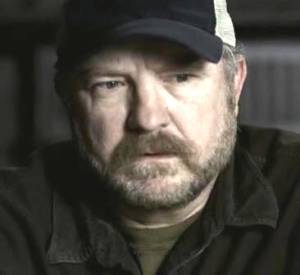
Robert Steven Singer is a fictional character in The CW Television Network's horror-drama television series Supernatural portrayed by Jim Beaver. Named after the show's executive producer, Bobby first appears in the first season finale "Devil's Trap." Although Beaver believed his role would merely be a "one-shot deal," Bobby has become a recurring character on the series, and is one of three characters who has appeared in every season of the show. The character, a "rough but warmhearted" working-class man who hunts supernatural creatures, has evolved over time into a father figure for series protagonists Sam and Dean Winchester. Critics have responded favorably to the character.

Ghost Rider is a fictional character appearing in American comic books published by Marvel Comics. He is the second Marvel character to use the name Ghost Rider, following Carter Slade and preceding Daniel Ketch, Alejandra Jones, and Robbie Reyes. The character's story begins when motorcycle stuntman Johnny Blaze becomes bound to the Spirit of Vengeance Zarathos after making a deal with Mephisto to spare his surrogate father. With his supernatural powers, Johnny seeks vengeance as the "Ghost Rider".

In Dante's Inferno, Satan is portrayed as a giant demon, frozen mid-breast in ice at the center of Hell. Satan has three faces and a pair of bat-like wings affixed under each chin. As Satan beats his wings, he creates a cold wind that continues to freeze the ice surrounding him and the other sinners in the Ninth Circle. The winds he creates are felt throughout the other circles of Hell. In his three mouths, he chews on Judas Iscariot, Marcus Junius Brutus and Gaius Cassius Longinus. Scholars consider Satan to be "a once splendid being from whom all personality has now drained away". Satan, also known as Lucifer, was formerly the Angel of Light and once tried to usurp the power of God. As punishment, God banished Satan out of Heaven to an eternity in Hell as the ultimate sinner. Dante illustrates a less powerful Satan than most standard depictions; he is slobbering, wordless, and receives the same punishments in Hell as the rest of the sinners. In the text, Dante vividly illustrates Satan's grotesque physical attributes.
Paradise Lost has had a profound impact on writers, artists and illustrators, and, in the twentieth century, filmmakers.
Lilith is a fictional character on The CW Television Network's drama and horror television series Supernatural. The series' writers conceptualized her as a dangerous new adversary for series protagonists Sam and Dean Winchester to face, introducing her to stabilize the story arc in the third season by giving demons a new leader in the wake of the death of the villainous Azazel and maintaining her as the primary antagonist until the conclusion of the fourth season. During the third season, Lilith tries to kill Sam and Dean, ordering for their deaths at the hands of her minions. Early in the fourth season it is revealed that her goal is to free her maker, the fallen angel Lucifer, from his imprisonment in Hell. The protagonists' attempts to thwart her plan is the main plot of that season.
The demon Belial, or characters named for him, have appeared in many examples of modern culture. This is distinct from medieval culture and Milton where Belial was related to the character in Jewish sources.
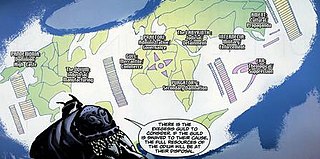
Hell is a fictional location, an infernal Underworld utilized in various American comic book stories published by DC Comics. It is the locational antithesis of the Silver City in Heaven. The DC Comics location known as Hell is heavily based on its depiction in Abrahamic mythology. Although several versions of Hell had briefly appeared in other DC Comics publications in the past, the official DC Comics concept of Hell was first properly established when it was mentioned in The Saga of the Swamp Thing #25–27 and was first seen in Swamp Thing Annual #2 (1985), all of which were written by Alan Moore and illustrated by Stephen Bissette and John Totleben.

Blue Devil is a fictional superhero appearing in American comic books published by DC Comics. He first appeared in a special insert published in Fury of Firestorm #24. That story led directly into Blue Devil #1, also cover dated June 1984. He was created by Dan Mishkin, Gary Cohn, and Paris Cullins. The Blue Devil comic book ran for 31 issues and one annual. Blue Devil later appeared as a regular character in Shadowpact which ran for 25 issues.
The Prophecy is an American fantasy horror-thriller film franchise, which focuses on angels fighting each other to protect the survival of the human race on Earth. Produced by Dimension Film, the series was established in 1995 with the eponymous first installment, The Prophecy, which has since been followed by four direct-to-video sequels. In 2005, its latest sequel The Prophecy: Forsaken was released on DVD instead of VHS.

Lilith, a biblical character suggested to be Adam's first wife and a significant female figure from Jewish mythology, has been developed over time into distinct characters in popular culture. One writer on witches, Judika Illes, wrote, "No spirit exerts more fascination over media and popular culture than Lilith. Her appearances are genuinely too numerous to count." Lilith is one of several figures with biblical or related origins integrated into popular culture who have been titled demon.
The Hebrew term mammon, personifying money in the New Testament, has led to many adaptations in literature, film, and popular culture.

Lucifer Morningstar is a fictional character and titular protagonist of the urban fantasy comedy-drama television series Lucifer. The character is portrayed by Welsh actor Tom Ellis and is based on the protagonist of The Sandman comic book series along with his own spin-off series, created by Neil Gaiman, both published by DC Comics' Vertigo publications. The character is based on the Devil from Christianity who has arisen to Los Angeles for a vacation from Hell with his ex-lover and companion, the demoness Mazikeen, to run a nightclub.











